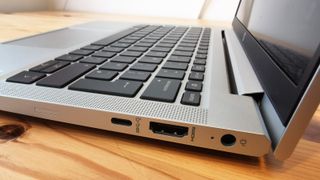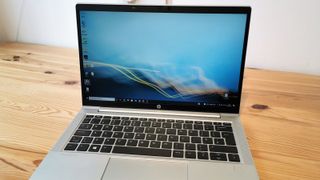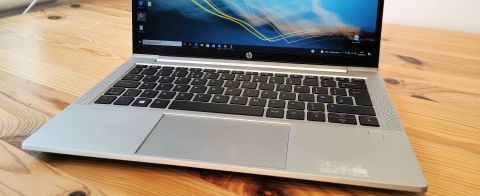TechRadar Verdict
Light, powerful and with fantastic battery life, the Aero 635 G7 is a notebook that almost has it all. But it isn’t very robust, and a few more ports would not have gone amiss.
Pros
- +
Lightweight
- +
Powerful
- +
Exceptional battery life
- +
Easy to upgrade
Cons
- -
Only one USB-C port
- -
Plastic construction is flimsy
- -
Needed Thunderbolt
Why you can trust TechRadar
Notebook designers are often caught between a metaphorical rock and a hard place when creating their systems. Customers want machines that last a long time on their internal batteries, yet they also want them to be lightweight and easy to transport.
Batteries make computers heavy so extending battery life increases the mass of the system, inevitably.
Part of the answer is to design systems where power efficiency allows them to be smaller and lighter, allowing for larger batteries without increasing the weight substantially.
Solve that chicken-and-egg conundrum, and customers will be beating a path to your door.
Considering how many laptops we see, you’d be amazed how few of them achieve that critical balance point between excellent performance and impressive battery life.
In some machines, you can tell that the engineers who designed it gave up with this ambition early in development, deciding either to go with battery life or performance, but not both.
HP thinks it might have the secret sauce on this subject in its new HP ProBook 635 Aero G7 Notebook PC. Can it offer a fruit-filled performance cake with an extra side-order of battery life flavoured Battenburg, or is that an unrealistic expectation?

Price and availability
As with all HP laptops, the exact specification of the HP ProBook 635 Aero G7 Notebook PC on offer displays some regional variation.
In the UK, the HP ProBook 635 Aero G7 with 8GB of RAM and 256GB of memory is typically near £850 from most online retailers, and the review hardware with double the RAM and storage would probably cost around £1,000.
US customers have the similar HP ProBook 635 Aero G8 direct from HP, an SKU that starts with a Ryzen 3 5400U processor for around $1,055 and goes up to only $1348.26 for one with the top tier Ryzen 7 PRO 5850 CPU option.

Design
The Aero 635 isn’t a radical laptop design. It’s the culmination of many notebook generations that have refined a form factor that most brands now use.
With a relatively small screen and landing area, designers must optimise space in a way that doesn’t make the user feel cramped or restricted at the keyboard.
This design was successful in those objectives, offering a practical keyboard layout that spaces the keys out. Occasional users won’t care, but those that do more data input will appreciate the ergonomics and the large touchpad that is easy to operate with either hand.
Positioning of ports isn’t ideal but not the worst we’ve seen on a notebook. Being such a thin profile, room for ports is only on the sides. And in this machine, ports are restricted to the back third of these edges.
The left side has a security slot, two Type-A USB 3.1 ports, and a 3.5mm audio jack, and the right is a pin-barrel power inlet, HDMI, a USB-C port and a mobile SIM card slot. Not sure why they provide the pin-barrel power receptacle since the provided PSU is for USB-C.

A better option would have been to put a USB-A and USB-C on each side and maintain the port count by including a USB-C to HDMI adapter.
One feature that might have been better is the camera. Mounted at the top of the screen, it has no physical means to obscure it. Reading the manual, it appears that some models do feature a ‘privacy cover’, but not on the review model.
But our most important takeaway from handling the Aero 635 was that some parts of the outer shell aren’t robust and border on flimsy in some places.
We’re sure that a conscientious person will get many hours of faultless service, but for someone who throws hardware around, this system might not last long.
Hardware
Here is the HP ProBook 635 Aero G7 configuration sent to TechRadar for review:
CPU: AMD Ryzen 5 Mobile 4500U
Graphics: AMD Radeon Graphics Vega with 512 MB DDR4 VRAM
RAM: 16GB DDR4 RAM, upgradable to 32GB
Screen: 13.3" diagonal FHD display natural resolution 1920 x 1080, 400 nits
Storage: SK Hynix BC511 M.2 480GB PCIe NVMe SSD
Ports: 2 x USB 3.2 Type-A Gen 1, 1 x USB 3.1 Gen 2 Type-C, 1 x HDMI, 1 x universal audio jack, 1 x SIM card slot (optional)
Connectivity: Intel XMM 7360 LTE-Advanced; Intel AX200 Wi-Fi 6 (2x2) and Bluetooth® 5 combo
Camera: 1x 720p HD camera
Security: HP fingerprint solution, TPM 2.0 security chip, Power-on authentication, Preboot authentication, etc.
Weight: 0.99 kg
Size: 307.6mm x Depth: 204.5mm x 17.9mm (W x D x H)
Battery: HP Long Life 3-cell, 53 Wh Li-ion
There are numerous notebooks available that fit into a niche predefined for them by the Intel platform on which they are based. Thankfully, it has taken a while to get here, but the penny has finally dropped with HP that there are alternatives and good ones at that.
Bult around the excellent AMD Ryzen 5 Mobile 4500U CPU, this choice enables the Aero 635 to have a dynamic performance curve and remarkably frugal power consumption.
With six cores and six threads, it’s superior to many recent 10th Gen Core i5 mobile processors. Only some 11th Gen Intel designs are consistently faster, and then only in some contexts.
The baseline clock is 2.3GHz, and the turbo mode can boost this to 4GHz for demanding single thread tasks.
Made on a 7nm fabrication, it manages this, and Radeon RX Vega 6 graphics on a TDP (Thermal Design Power) that has a scope of 10-25w and typically only 15w.
In the review configuration, the Ryzen 5 Mobile 4500U has two SoDIMM DDR4 memory modules for a maximum of 32GB of RAM and a 500GB Hynix NVMe M.2 SSD. The M.2 slot is Gen3 specification, and HP offers a 1TB drive on some SKUs.

It might be possible to put a 2TB or 4TB module in here for those that like doing upgrades, but we’d be careful about putting any SSD inside that tends to run hot.
If this design has a weakness, HP didn’t give it a Thunderbolt port and only a single USB-C receptacle. To compound that limitation, the USB-C port is required for charging, making it less available for attaching external storage or USB-C compliant displays.
The only practical way to address that limitation is to use a USB-C docking station, but a Thunderbolt dock would have been better if it had that technology.
HP deserves some credit for finally accepting what many other brands realised a while ago, that pleasing Intel and their customers aren’t objectives that inevitably coincide. Hopefully, we’ll see more AMD Ryzen products from them soon.
- 1
- 2
Current page: Introduction, price, design and hardware
Next Page In use, performance, upgrades and verdictMark is an expert on 3D printers, drones and phones. He also covers storage, including SSDs, NAS drives and portable hard drives. He started writing in 1986 and has contributed to MicroMart, PC Format, 3D World, among others.
Most Popular


